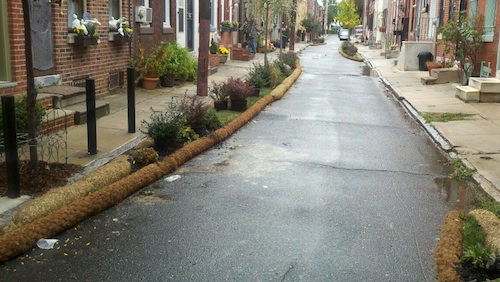A biweekly newsletter with public space news, resources, and opportunities.
A curated dispatch on all things public markets plus the latest announcements from the Market Cities Program.
Philadelphia is joining the ever-growing group of American cities leading the way toward livable streets. It seems appropriate that the birthplace of our constitution is now providing leadership in streets designed by the people, for the people and of the people.
Often, livable streets movements start at the grassroots level, and after increasing pressure, the city government responds. Interestingly, in Philadelphia, the democratic streets movement appears to be occurring simultaneously at grassroots and institutional levels.

Drawing attention to the current street renaissance is Better Blocks Philly, a 10-day project of community-driven temporary street changes that runs through October 23. Leading the project is the South of South Street Neighborhood Association (SOSNA). With the help of several Philadelphia engineering and design firms, they've constructed temporary street changes on streets within the Graduate Hospital neighborhood. The end goal is to demonstrate the value of "complete streets" concepts to neighbors.
SOSNA invited me to help kick off their project by speaking on October 13 about how to use Completing Streets to foster Placemaking and what PPS calls "Streets as Places." The attendees responded well to a dialogue about how Placemaking principles can help reverse the long-term damage that Jane Jacobs attributed to the 20th Century trend of tuning our streets for the car, which has gradually nibbled away at our communities.

With the support of the city, SOSNA installed temporary bump-outs, mid-block crossings and pop-up parklets that double as bump-outs. The parklet at the corner of 17th Street and Christian served as a wonderful outdoor café for those of us waiting for the kickoff event to begin. The SOSNA residents had hoped to install several other features, such as mini traffic circles, but city staff have plans to pilot those elsewhere in Philadelphia.
The city is certainly not sitting on its hands while neighborhoods are fermenting change. In 2009, it painted buffered bike lanes on Pine Street and Spruce streets in Center City on a temporary pilot basis. This was an experiment to determine the effect that the elimination of a travel lane and replacement with bike lanes would have on all modes of traffic. Since each street was scheduled to be resurfaced a year later, this was a low-cost, low-risk experiment.
Both engineers and citizens participated in the evaluation, and the experiment was judged a resounding success at all levels. Crashes for all modes went down. Most notable was a 34 percent decline in crashes that resulted in injuries requiring a trip to the hospital. Surprisingly, crash rates even went down for motor vehicles, which is attributable to elimination of speeding by the 15 percent of the motorists who used the extra lane to dangerously weave in and out at well above the speed limit.


Cycling rates on the street increased, riding on the sidewalks decreased, pedestrians felt safer -- and all of this was accomplished without reducing travel times and traffic volumes.
Encouraged by the success of the pilots on Spruce and Pine streets, the city decided to try its hand at reducing the cross-section of Market Street between 15th and 20th streets. This truly shows courage of conviction -- Philadelphia City Hall is located at 15th and Market! Market Street is also a major destination street in Center City, while still needing to handle traffic.
City staff feel confident that it has more than enough lane capacity to handle traffic even after a lane reduction. But to test the theory, they've decided to close one lane off temporarily using orange cones and barrels. It the experiment goes as the city expects, the reclaimed lane on Market Street will be reprogrammed with a bike lane, landscaping, and improved pedestrian crossings.

Read more about the Market Street project on NewsWorks, and find out more about Better Blocks Philly on their Facebook page or on their website.
The rich text element allows you to create and format headings, paragraphs, blockquotes, images, and video all in one place instead of having to add and format them individually. Just double-click and easily create content.
The rich text element allows you to create and format headings, paragraphs, blockquotes, images, and video all in one place instead of having to add and format them individually. Just double-click and easily create content.
Body Text Body Link
The rich text element allows you to create and format headings, paragraphs, blockquotes, images, and video all in one place instead of having to add and format them individually. Just double-click and easily create content.
Here is some highlighted text from the article.




Headings, paragraphs, blockquotes, figures, images, and figure captions can all be styled after a class is added to the rich text element using the "When inside of" nested selector system.
Headings, paragraphs, blockquotes, figures, images, and figure captions can all be styled after a class is added to the rich text element using the "When inside of" nested selector system.
Headings, paragraphs, blockquotes, figures, images, and figure captions can all be styled after a class is added to the rich text element using the "When inside of" nested selector system.